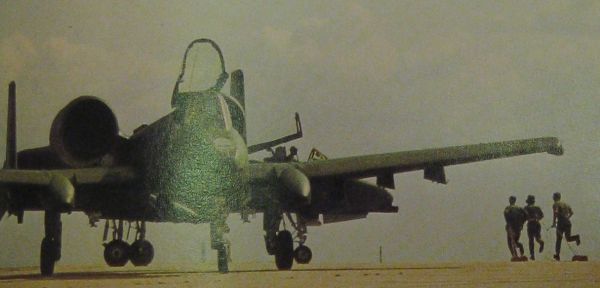Former Australian Deputy Secretary of Defence on Able Archer 83

US Ground crews race toward an A-10 to prepare it for another sortie during Autumn Forge 83, the conventional precursor to the nuclear Able Archer 83. From Air Man.
The Australian Strategic Policy Institute has just published an engrossing “special Report” on Able Archer 83, written by Paul Dibb, who served on the Australian National Assessments Staff, National Intelligence Committee, and as Deputy Secretary of Defence.
Dibb, who is now a professor at Australian National University, presents an accurate overview of Able Archer 83 and the factors leading up to it. ** His use of his past experiences makes the paper even more readable. He visited Moscow twice in 1983 (“there was a real sense of war fever being whipped up in Moscow”), and met the double-agent who reported the Soviet fears, Oleg Gordievsky, in 1987 (the same year as Reagan). His recollections about the still controversial KAL 007 shoot down are also very interesting –he writes that there was a US RC-135 reconnaissance plane in the area that he believes the Soviets mistook the Korean airliner for, and that the “US administration’s rhetoric outran the facts that were known to it.”
He also found a George Kennan quote which I hadn’t seen before: the situation in 1983 possessed “the unfailing characteristics of a march towards war –that and nothing less.” (From Kennan, At a Century’s Ending.)
In my opinion, the conclusions Dibb draws from the Able Archer 83 war scare are spot on. He writes:
What do we learn from all this? First, that in November 1983
the world stood on the edge of the nuclear abyss without
our American ally even realising it. This was a frightening
case of intelligence failure because of an inability to read the
paranoia of the Soviet leadership. In May 1984, a top-secret
Special NIE, called Implications of recent Soviet military–
political activities, reviewed recent Soviet military activities
and statements, but—despite the evidence that the CIA had
seen from Gordievsky—it continued to argue that ‘the Soviet
leadership does not perceive an imminent danger of war.…
I note here that the first Australia would have known about
all this would have been Soviet nuclear strikes on US facilities
at Pine Gap (near Alice Springs), Nurrungar (Woomera) and
North West Cape (near Exmouth). We know that this was
likely because Western spies for the Soviet Union in the late
1970s had given Moscow some insights into the significance
of these intelligence and communications facilities for what it
saw as US nuclear war-fighting strategy.….
Like most disasters, this one would have resulted from a
confluence of errors and misperceptions. In this case it was
the profound distrust between the two sides, a sequence of
preliminary events that included the shooting down of the
airliner, and—perhaps most importantly—an intelligence
failure on the behalf of the US. That such a situation could
come about after three decades of Cold War, with all the
elaborate mechanisms that had been hammered out over the
years, is sobering. It’s worth understanding what happened—
and what could have been done to avoid it—when we
contemplate the growing strategic competition between the
nuclear-armed US and China in our region today. The serious
message to be taken from this paper is that we shouldn’t
be complacent when it comes to contemplating the risk of
nuclear weapons being used one day.
Dibb cites the National Security Archive’s three Electronic Briefing Books on Able Archer 83 as “the most comprehensive primary sources for further reading.” They can be found here.
___________________________
One comment: Dibb writes that Able Archer 83 “was planned to involve high-level officials, including the US Secretary of Defense and the Chairman of the Joint Chiefs of Staff.” The primary sources I have seen have not mentioned this. A SHAPE (Supreme Headquarters Allied Powers Europe) summary of Able Archer 83 describes “Response cells from the United States, United Kingdom, and NATO (no other nations) participated in the exercise. The Joint Chiefs of Staff in the US and Ministry of Defense in the UK participated ‘with small response cells.’ The NATO response cell was simulated by the Exercise Directing Staff.”
FOIA requests to the US Department of Defense about the composition of these “response cells” remain open as the DOD continues to process them.

Comments are closed.